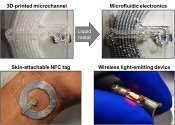New 3D printing technique integrates electronics into microchannels to create flexible, stretchable microfluidic devices
The transition from traditional 2D to 3D microfluidic structures is a significant advancement in microfluidics, offering benefits in scientific and industrial applications. These 3D systems improve throughput through parallel ...
Jun 12, 2024
0
52









